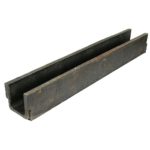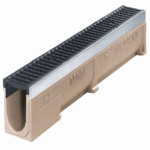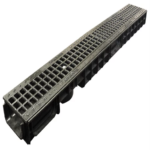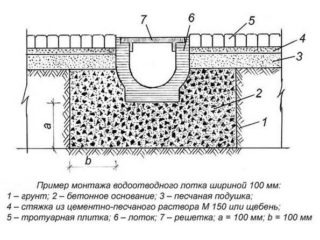The volume of melt water and rainfall falling on the roof of an ordinary building can be 100 m3. If the water is not drained, it will collect in puddles and destroy the roof and base of the house. Storm sewage is a complex system consisting of pipelines and sedimentation tanks. At the first stage, precipitation is collected in receivers, which include rainwater drainage trays.
Scope of application of drainage trays with a grid
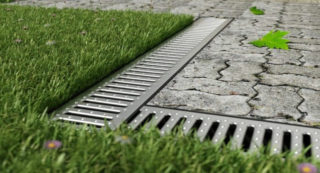
Rain trays are installed in crowded places of people and vehicles: pedestrian paths, driveways, train stations and airports. Storm rain is an integral part of construction projects, so the owner of a private house needs to take care of the drainage system himself in order to protect the property from precipitation.
Advantages of drainage trays:
- durability;
- strength;
- moisture resistance;
- frost resistance;
- resistance to seasonal temperature changes.
A wide range of trays of different sizes, made of concrete, plastic and composite materials, will allow you to choose the best option for solving the problem of primary collection of sediments.
Manufacturing materials

Inlet trays are manufactured according to approved standards. They can be rectangular, square or U-shaped, rounded. From above, the products are equipped with gratings that protect the storm sewer from blockages. Collecting branches and other large debris, they prevent passers-by from stumbling into grooves filled with water and additionally add aesthetics to pedestrian and traffic areas.
For the manufacture of rain trays, traditional building materials and plastics are used.
Concrete
In the production of monolithic gutters, fiber-reinforced concrete is used. It is a type of fiber reinforced cement concrete. The most durable and reliable products with low cost cope with large flows of water and withstand significant weight loads. Fiber concrete is inert to the effects of aggressive chemical impurities contained in storm waters, therefore, concrete trays are used to drain sediments from road surfaces and from building foundations.
Disadvantages:
- large weight of the structure;
- high cost of transportation;
- complexity of installation;
- the need to attract loading equipment.
Another disadvantage is the laboriousness of the installation work, since it requires the involvement of a team of workers to unload and install the stormwater.
Polypropylene and polyethylene
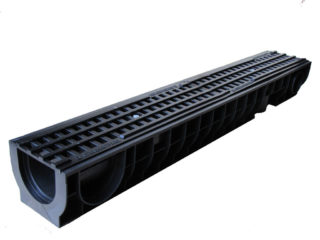
The smooth surface of plastic products easily allows streams of water containing debris to pass through. Modern plastics are highly resistant to chemicals. These trays weigh up to 15 kg, so there are no problems with transportation. The products can be easily installed by hand without the use of heavy forklifts.
Disadvantages:
- high price;
- low strength.
Plastic products have a limited lifespan. In this respect, they are inferior to concrete gutters.
Polymer concrete
The combination of the advantages of plastic and concrete makes products attractive to buyers.For their manufacture, granite chips or quartz sand are used; epoxy and polyester resins are used as a connecting compound. The resulting conglomerate successfully replaces cement. Products made of polymer concrete are lightweight, and their strength and elasticity increase. The drainage capacity is increased compared to rough concrete gutters. They also carry the maximum weight load.
Polymer sandstone
Another modern conglomerate with the addition of polymer chips. It is based on fine sand. After heating up to the melting point of the composite materials, the mixture enters the press. Thanks to quartz, the trays acquire strength, and the polymer gives elasticity, which increases resistance to mechanical stress. In terms of cost, they are somewhat superior to concrete products, but have half the weight.
Cast iron
Heavy and expensive cast iron products have not gained popularity, although the material has good strength, due to which the trays have a long service life.
Dimensions of drainage trays
Concrete and reinforced concrete gutters are manufactured in accordance with accepted standards: their length is 1 m, the height of the structure is from 9 to 76 cm, and the width is from 10 to 50 cm.
Plastic trays have the following standards: with a length of 1 m, the width can vary from 14 to 20 cm, and the height from 6 to 30 cm.
Polymer concrete products: with a length of 1 m, their width changes from 7 to 30 cm, and their height from 5.5 to 12.5 cm.
Polymer sandstone drainage trays: with a standard length of 1 m, the width is 140 mm, and the height varies within 7-12.5 cm.
Criterias of choice
The main selection criterion is compliance with the expected load. Trays designed to drain water from parking lots and highways are different from rainwater inlets for garden plots, private houses and garages. The throughput of drainage products is necessarily calculated.
When choosing a material of manufacture, one proceeds from the expediency of costs and the durability of products. Each tray has its own class, according to which it can withstand the specified load.
Class A15 includes trays with a capacity of 1.5 tons. They are usually used for the installation of storm sewers in private estates, at playgrounds and sports grounds. Class B125 indicates resistance to a weight of 12.5 tons. Such products are in demand on roads with little traffic.
Installation features
- Draw up a plan for the placement of the trench. It is necessary that it has a slope of 1 cm per running meter for the gravity movement of water.
- The bottom of the dug trench is tamped.
- A pillow is formed from sand for trays or gutters.
- The bottom and sides of the trench are poured with concrete, on top of which the trays are installed end-to-end, for this they are lightly tapped with a hammer to give the desired position.
- On top of the trays, gratings are installed at a distance of 5 mm from the ground surface. Turning inserts are used when cornering.
At the final stage, the seams between the trays are sealed with a sealant. If necessary, sand traps are installed before installing the trays.
Cost of trays
The price of the products depends on the size, the selected material, the load class, the shape of the lattice - cellular or slotted. The manufacturer lowers prices for bulk purchases.
- Plastic complete class A products can be purchased from 513 to 576 rubles, Park class within 6842-7483 rubles.
- Concrete gutters buy from 250 to 477 rubles.
- Polymer sand products cost from 422 to 465 rubles, polymer concrete from 944 to 1732 rubles.
- Prices for drainage trays with cast iron gratings: plastic class A with dimensions 125 * 75 costs 660 rubles.
- Plastic with galvanized steel grating 125 * 74 has a cost of 512 rubles.
Steel gratings are galvanized to prevent corrosion.A drainage tray with such a grid has a lower cost, which makes the product more popular.
The consumer often chooses polymer concrete trays, although they have a fairly high price and low adhesion (adhesion) to the cement mortar. However, plastic gutters are the least durable and concrete products are too heavy.

